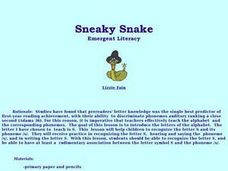Curated OER
Essential Strategies for Teaching Phonemic Awareness
Although designed for those new to teaching phonemic awareness, the strategies and activities included in this 25-page packet are sure to engage kids and help them develop these essential skills.
Curated OER
Sssssssss
Students experience the strategy of phoneme recognition to recognize /s/ in spoken words, including plurals, and in writing. They encounter the book Summer Fun by Lucy Lawrence and the tongue twister "Miss Sam saw a sneaky slimy snake in...
Curated OER
The Beautiful Bouncing Ball
Students practice recognizing a letter and its phoneme by utilizing the alphabetic principle while working with and identifying the sounds of /b/. They assess a big book, objects in the room, a timer and the tongue twister, "Billy...
Curated OER
the Little Red Riding Hood
Students respond to the story of Little Red Riding Hood. In this Red Riding Hood lesson, students retell and discuss story elements. Students practice phonic sounds. Students role play, make predictions, use picture...
Curated OER
Phonics Diagraph
This simple presentation is designed for very young readers who are just starting to learn their consonant blend sounds. Pictures of a shark, a chicken, a whale, and a moth help introduce these blends.
Curated OER
The Best Pet
Students listen to the story , Pet Show, and discuss the variety of animals that were in the show. The class recalls the animals and practice sounding out the names. Then they decide which animal should receive the best of show ribbon.
Curated OER
Putt-Putt Old Car
Students study the phoneme /p/ both in written and spoken language while differentiating from the phoneme /b/. They think about the "put, put" sound that an old car makes, and work with at tongue twister. Next, they write the letter p,...
National Science Teachers Association
Using Concept Maps in the Science Classroom
A good concept map requires high thought processes. This makes it a great tool for teaching and evaluating your pupils. A helpful article describes a great approach for teaching young scholars the art of concept map building and how best...
Curated OER
Silly Sally Sings Upside Down!!!
Students use phonics to recognize the /s/ sound. As a group, students recite tongue twisters to recognize the /s/ sound. Students search through magazines to find objects that contain the /s/ phoneme.
Curated OER
Trucks and Community Workers
First graders identify community helpers and their roles. In this transportation lesson, 1st graders complete a series of lessons integrating technology and literacy. Students decode sounds of short u, c/s/ and g/j/ words and improve...
Curated OER
Reader Rabbit 1
Second graders participate in a reading activity in order to improve phonics skills. They generate the short vowel sound in CVC pattern words. Students blend beginning consonant, short vowel sound and final consonant into words.
Curated OER
Eloquent Speech
Second graders discover that oral and written communication can be improved, and made to sound more eloquent, when the following questions are addressed; Who? What? Where? When? Why? students use word processing to copy a poem using clip...
Starfall
Zz is for Zebra
In this printing worksheet, students form 11 upper and lowercase letter Z's. Students color in pictures of words beginning with the letter and write two rows of Z's on their own.
Curated OER
1st Grade - Act. 16: Dancing Mice
First graders creating mouse attached to a helium balloon, and dance around to the sound of some fun music.
Curated OER
Why Your Ears Pop
For this ears worksheet, learners read about what causes your ears to pop when you change altitude and about equalizing air pressure. Then students complete 3 short answer questions.
Curated OER
Slithering Silly Snakes
First graders identify the letter and phoneme /s/ in written and spoken language. Students practice the production of the /s/ sound through tongue twisters. They identify the initial placement of the letter and sound by creating a...
Curated OER
And The Oscar Goes To?
Third graders complete a graphic organizer to determine what a good story looks and sounds like. Using various forms and conventions, they determine which style to use for different audiences and purposes. They write their own story and...
Curated OER
Writing With Dolch
Students increase their skills in word attack, fluency, and spelling of words and research and find information on topics from the Internet. They then use the Quick Cam with the computer and will increase cooperative skills in small...
Curated OER
Sneaky Snake Emergent Literacy
Students are introduced to letters of the alphabet, specifically the letter S. Students recognize the letter S and its phoneme /s/ and receive practice in recognizing the letter S, hearing and saying the phoneme /s/, and in writing the...
Curated OER
"Whaaa" Said The Baby"
Students recognize phonemes that correspond with the letters in the alphabet. They focus on identifying the short a, /a/ sound. They examine the way their mouths move when making the short a sound mimicking a baby's cry. In given...
Scholastic
Transitional Guided Reading
Use a fill-in-the-blank lesson plan template to enhance your guided reading lesson plans with details surrounding decoding strategies, fluency and phrasing, vocabulary strategies, comprehension, and more!
Curated OER
ESOL Competencies: Telephone Communication
Help, there's an emergency! Adult English language learners need to know how to express concern and call for help in an emergency. Provide them with this comprehensive list of vocabulary and lead them through the exercises given....
Curated OER
Adjective Lessons
Learning about comparative, superlative, and proper adjectives can involve hands-on activties.
Curated OER
Describing Paintings: Calm or Stormy
Young writers use nouns, verbs, and adjectives to describe details in two paintings. One depicts a sunny landscape, and the other shows a cloudier view. They write a narrative inspired by the paintings, paying attention to transitional...

























